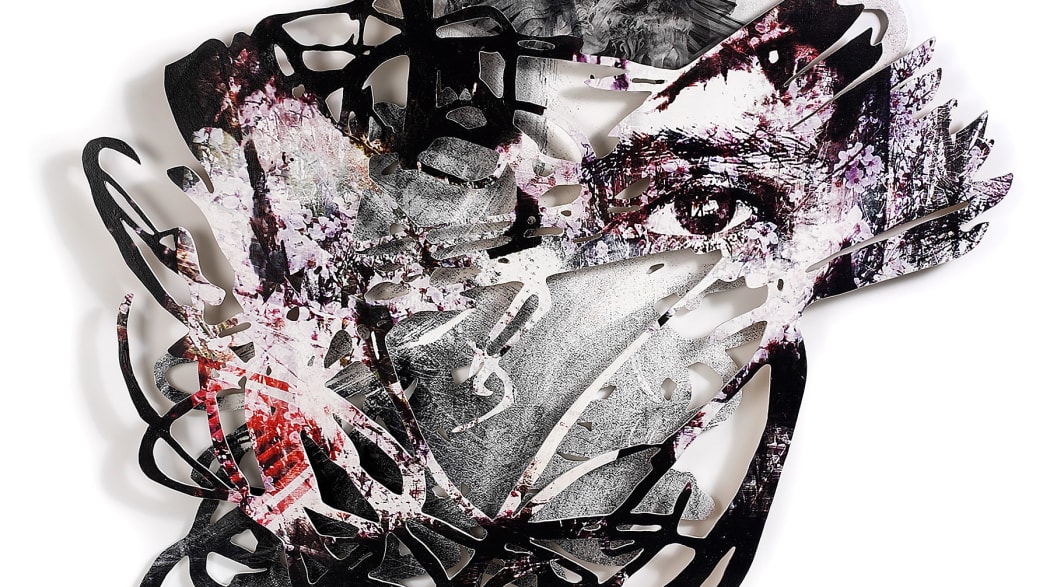
At an event like The Medium Festival of Photography there are plenty of opportunities to discover new means of artistic expression through photography-based works. The works exhibited ranged from excellent craftsmanship in the traditional use of photography, both as film-based silver gelatin and digital work to sculptural applications. From the many excellent photographers at Medium, four gave me pause to consider their work more deeply: Rob Grad, Krista Svalbonas, Drew Leventhal and Jodie Hulden.
Rob Grad (1), previously a professional musician, has over the last several years, transformed into a photographer blending images with other media. His work demonstrates an interest in experimentation as to how he wants to express his vision. The series “With Open Eyes” is designed to grab and engage the viewer with the image. Grad explains: “ This series began with a collection of close up black and white photographs I took of peoples’ faces. …I found myself particularly attracted to their eyes, so I experimented with overexposing the images to minimize facial context. The eyes seemed to lack emotional attachment to the particular moment and embodied a depth of experience. Distractions like race and gender also became less important….our eyes are the most contrasted points on our face, so they are naturally what we are drawn to … “Four Eyes” is a self-portrait. It contains a simulated multiple exposure of three separate black and white images of my eyes (the fourth eye is implied at the top), layered with photographs I took of objects and nature in two different locations where I’ve lived. …“Four eyes” was a derogatory term used in my childhood for kids with glasses. The term was also used as a condemnation of children who were either intelligent, or desired to be so”.
The works are three dimensional pieces, with a combination of painting and photography layered on to two or three layers of plexiglass and wood. The surface materials used may be hand cut into various shapes, not just square or rectangular. “All of the shapes in this series are hand drawn and hand cut from the wood using a hand router. The plexiglass accents are cut by machine due to the difficulty of the material, but the shapes are also drawn by hand.” The viewer gazes at the art object looking for a photographic image hidden amidst swirls of paint on multiple layers. There is a careful delicate balance between the presence of the image and the use of other media. The image would be out of visual balance if one dominated the other. There is a sense of chaos in the images, but as one looks more closely, an eye and face will emerge.

Another of Grad’s portfolios, “Through a Cloud of Noise”, is done in black & White. As in “Four Eyes”, the longer the viewer looks at the image, the more the details of the image emerge. Unlike the portfolio “Four Eyes”, he chose to print the image in black and white to highlight the emotion of the subject without the distraction of color. “These photographs that clearly had one subject in a contemplative moment amidst the busyness in the street surrounding them”. He again surrounds the image with painted swirls and lines infusing the image with a sense of chaos. There is a connection between the works as Grad developed his feelings about different situations he observed. He commented that : “[t]hese two series are most related by the use of physical space between the layers, and the gestural language…to represent the atmosphere and energy of the subjects and/or situations. The physical space between layers in both series conveys distance between what may or may not be happening internally, versus the outside world. … In “With Open Eyes,” the space is more about giving physical space to the various conflicting aspects of our personalities, and trying to connect to each other as humans in the midst of that.”
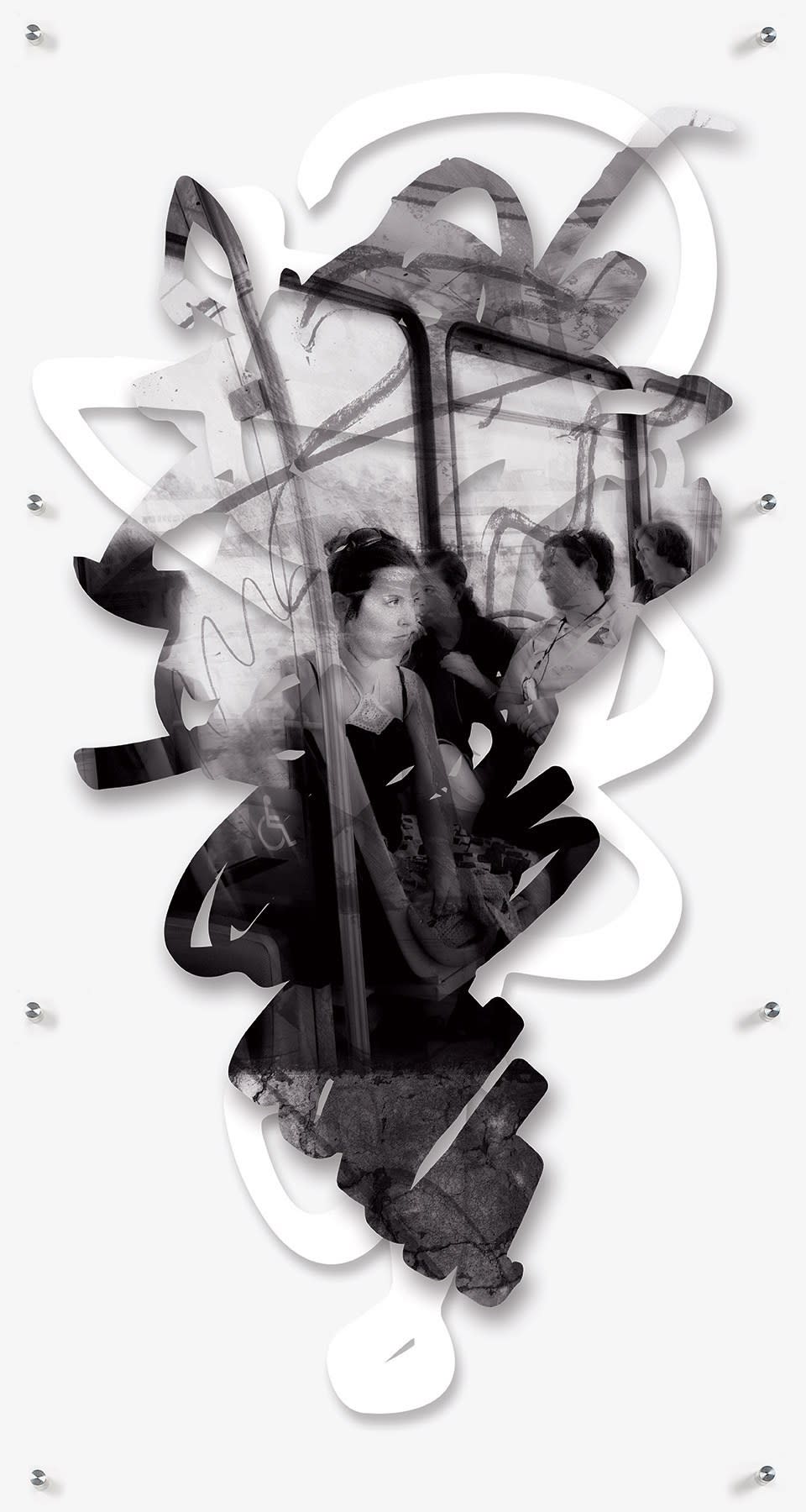
Several artists influenced his work. He quickly mentions Jean-Michel Basquiat, Robert Rausenberg, and Joan Miro, as well as Aaron Siskind and the abstract quality in their art. With photography, we most often capture a literal image of what we see. In other cases, a literal image is taken, but stitched with other images, blended into a panorama or layered into a collage. Here, Grad takes four extra steps from what we normally expect with a “photograph”: he adds other media, a non-paper surface in the use of wood and plexi; the surface in “Four Eyes” is not just square or rectangular, but cut in wild flows and swirls; paint and varnish are added; and, then photographs, applied to the non-traditional surface in a non-traditional process. It will be interesting to follow Grad as he continues to refine and balance his photographic images against the use of other materials within these unique art objects.
Krista Svalbonas (2) is another artist who is following a non-traditional path of photography-based work. Where Grad’s work was internally focused, Svalbonas has a focus on the environment that surrounds and embraces us. Like Grad, her work is multi-disciplinary and sculptural.
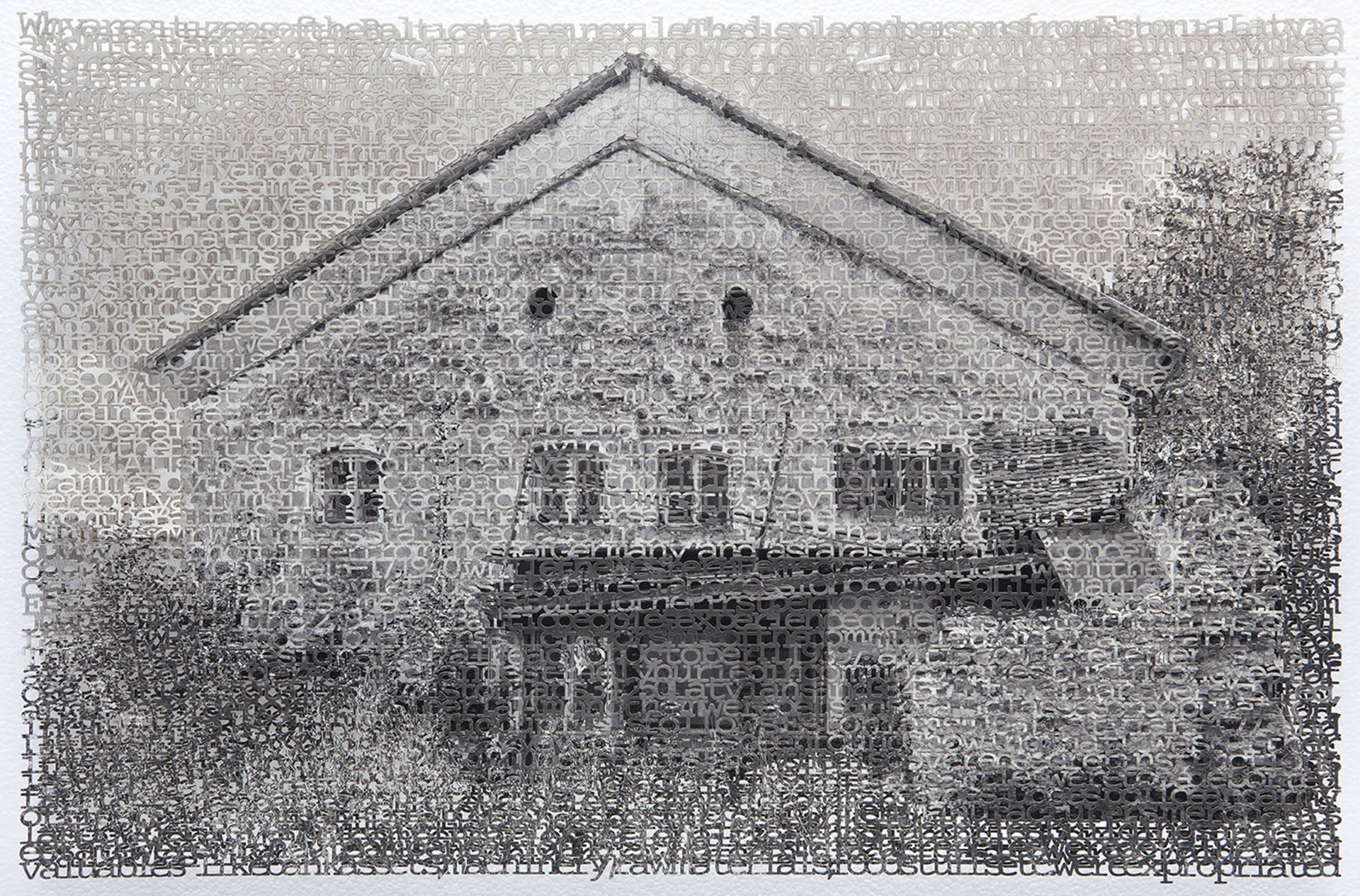
She has a longstanding interest in architecture, particularly urban environments. Her images contain old buildings and new. However, there are two intensely different motives and styles in the presentation of these structures. One series is “Displacement” and the other “Migrator.” The series “Displacement” is about the memory of departing a place. “Migrator” is the experience of arriving in a new unfamiliar place.
Displacement is a series that follows her family’s post-WWII experience emigrating from the Latvia/Lithuania to the United States. She commented: “My past work has dealt with low-income housing complexes; modernist architectural ideals, drawing from Le Corbusier, Mies van der Rohe, and Soviet architecture; and the phenomenology of space. I am fascinated by the language of spatial relationships and by the effect of architectural form and structure on the psychology of the human environment. … My parents spent many years after the end of World War II in displaced-person camps in Germany before they were allowed to emigrate to the United States. My connection to this history has made me acutely aware of the impact of politics on architecture, and in turn on a people’s daily lived experience. My work explores architecture’s relationship to cultural identity, social hierarchy, and psychological space”. Svalbonas comments that the displaced person camps and the buildings used which she has been photographing are constructed cheaply without insulation, adequate plumbing or heating. These physical spaces impact how people in a transitional situation feel and exist.
She has cleverly conveyed an historic experience in combining a photograph of place with the words from the letters of refugees, of that place, who are seeking to move on to another country. Svalbonas commented that, for these emigrants, “‘home’ were temporary structures, appropriated from other uses to house thousands of postwar refugees. These transitory spaces of mass habitation, demolished and rebuilt over the years, have left only a vague imprint on the earth. … ‘Displacement’ captures the traces of this existence by drawing on historical refugee letters as well as my photographic documentation, combining past and present in a series of laser cut images on photographic paper. …laser cutting plea letters the refugee were sending [into] the photographs.” The multi-layers of images in her work give a sense of presence and depth to a free-standing cultural art object.
Svalbonas realizes that photography is not only a tool for expression and to capture what exists, but is a critical link to one’s own past and history. “[P]hotographs were among the few possessions my family was able to take with them when they fled the Russian occupation. Photographs documented a home and a country that most Baltic refugees, including my parents, thought they would never see again. I was raised on these visual memories, and the accompanying stories of a “homeland” that remained distant and inaccessible — until the unimaginable happened in 1991, when the Baltic states regained their freedom”. Vernacular images are usually intended for personal use only, but life events may make these images a link needed to communicate about our past, present and future. 3

The “Migrator” series are three dimensional images that look like wall sconces. While the “Displacement” series are three dimensional sculptural objects of art that set to rest on a flat surface like a table, the “Migrator” objects are sculptural objects that are intended to be mounted on a wall and angel out. Unlike “Displacement, which is a single building, physically cut and defaced by the words from emigre’s pleading letters, “Migrator” are photographic images of new and old buildings from cities in the United States: New York, Philadelphia and Chicago. These are images of a new life. Images of a new place very different form the pace the immigrant has left. The objects seem to convey the awe, sense of discovery and amazement of life in a new place. Each of the “Migrator” sculptures in the series differ from each other in shape, images used and architectural perspective, but convey a similar sense of wonder and discovery.
When asked who influenced her work, she commented: “Because of my interdisciplinary nature, I often find sculptors to be the most inspirational artists with my work,… I adore Gordon Matta Clark. I am often in awe of Rachel Whiteread. I immensely enjoy the work of, Erin O’Keefe, Georges Rousse, Letha Wilson and Lisa Sigal.” The strong connection between photography and sculpture is discussed in a related Foto Relevance Commentary “Paris Photo: Trends in Photography (November 28, 2016)”. (4)
Another artist at Medium, Drew Leventhal (5) has experimented in the abstraction of images within a very traditional photographic image. While, Grad and Svalbonas physically abstracted with mixed-media their photographic images, Leventhal keeps his images in a traditional two dimensional work on paper, but abstracts the image within the defined space of the paper.
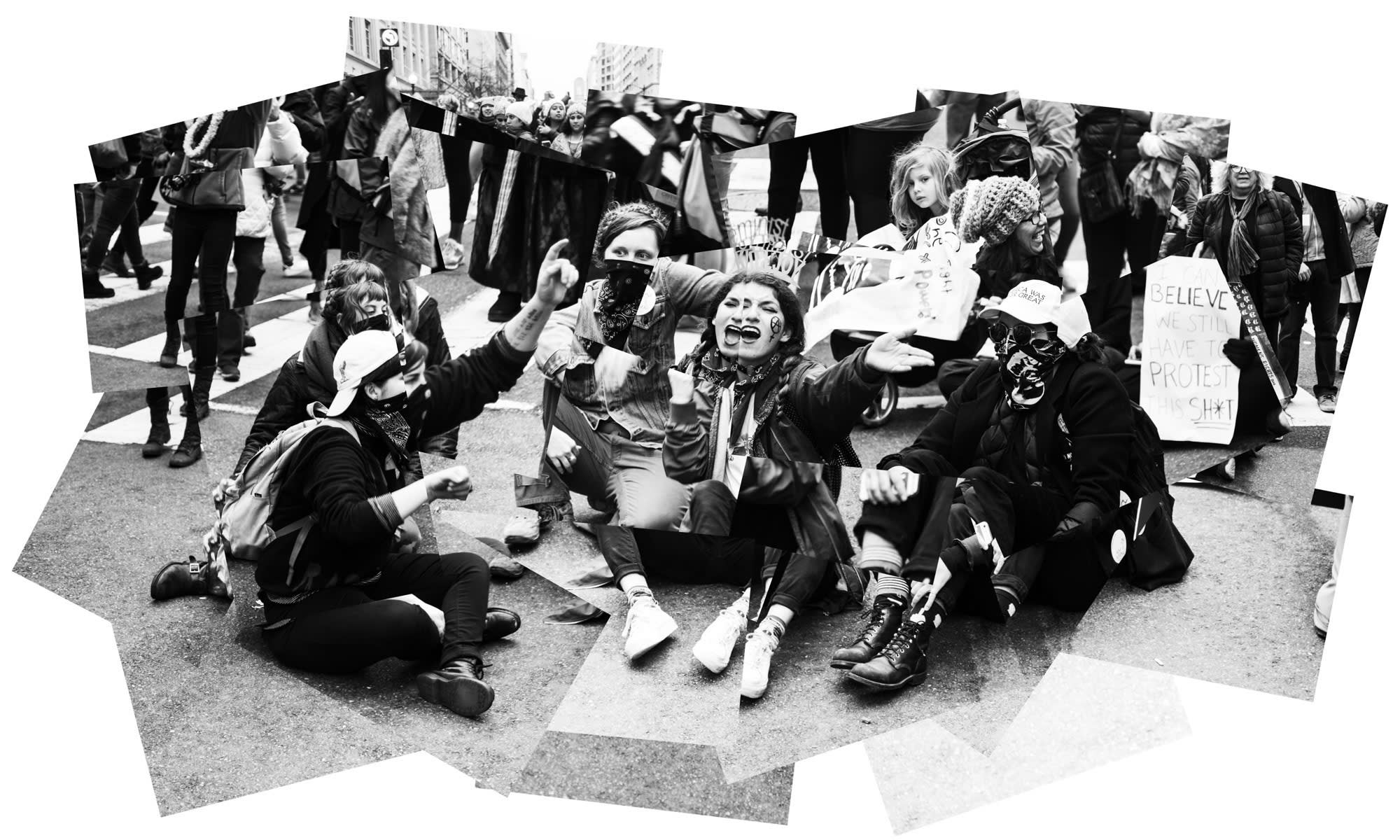
His portfolio reflected a number of themes that hit on the challengingpolitics of our time. It was striking how the image of protestors, taken recently, could just have well been taken in the 1960”s/70’s. While the image could be documentary or vernacular, the combination of many images, reminiscent of David Hockney’s style, makes these images speak loudly and reverberate a sense of motion, action and commentary. These invite the viewer to participate and engage in what is happening. His style of capturing and presenting protestors, as he has done, confronts us with a timeless question of who are they, where are they, and what is driving their exercise of the right of political expression? The discussion is not directed, but open ended. What is wonderful about his technique and compositions is how we are forced to examine the image for clues. The only truly visible statement in his image “Sitting Protestors” is a sign that says “ I can’t believe we still have to Protest this sh*t”. We then see on a white cap of another protestor the hint of words “America”, “was” and “Great”. We can only guess what the full statement night be. On another protestor we see a crown that hints at the word “feminist”. We also observe that all the visible protestors are girls and women. Even though the image does not betray when it was taken, one might assume that this is a current social discourse in one of our major cities triggered by an issue with our current government. The fragmented arrangement of the image is the explanation point on all other hints within the photograph.
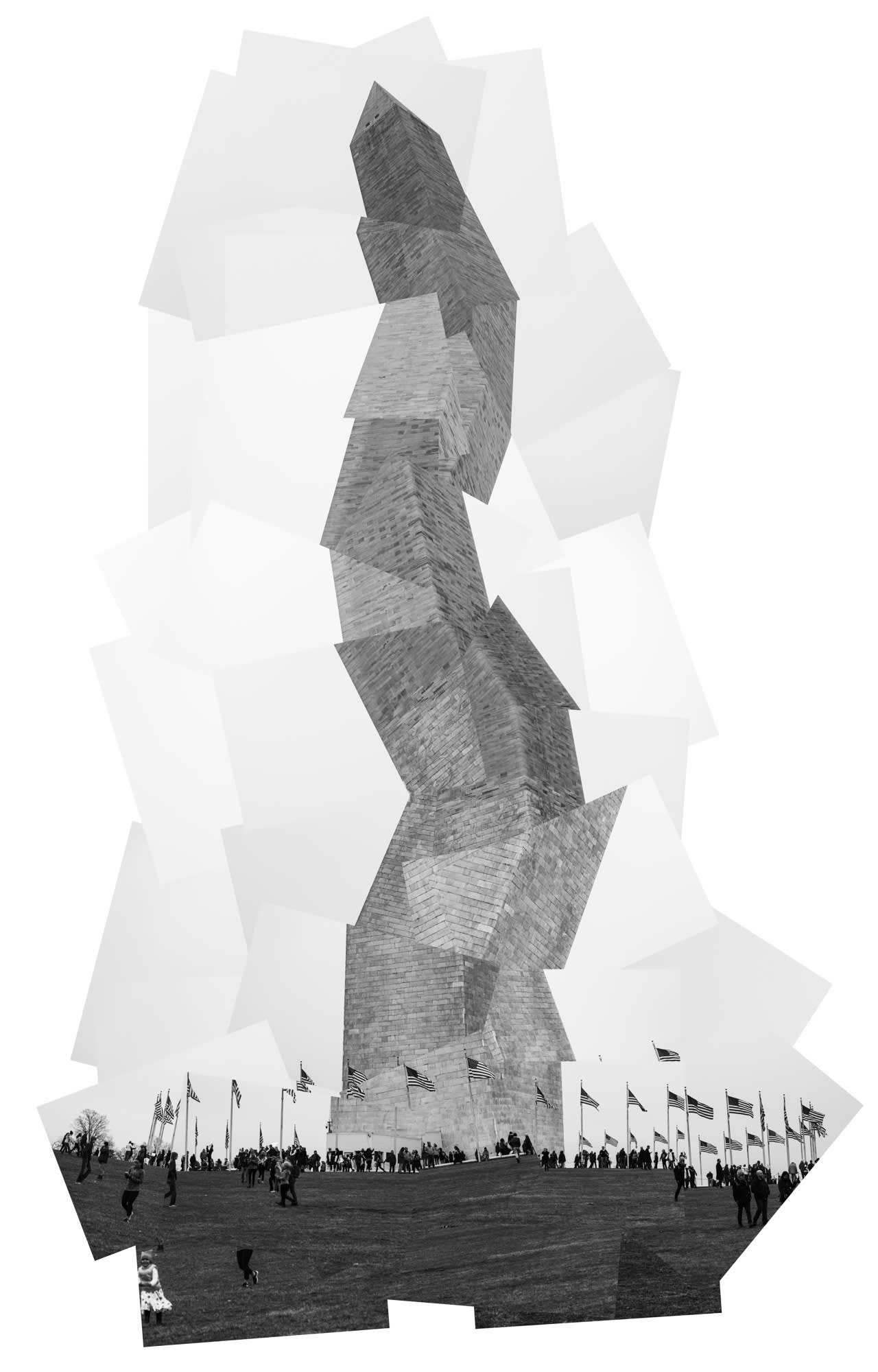
With his image of the iconic Washington Monument, he challenges what we might think about our institutions. This is especially true with today’s dialogue on statues of soldiers of the Confederacy and their place, or not, in our visible culture in public places. Leventhal’s image of what appears to be a collapsing Washington Monument ties well with the other image of protestors. It’s as if Leventhal is suggesting America should be politically awaken to what is happening today. It is a a visual scream to look at what our leaders and institutions are doing. It is a visual statement as to whether we should remember that people have a voice and power within our fragmented political system that can be heard, or lost if not exercised. His images are an exercise of his voice. The question as to their effectiveness and reach is whether others look at these images and “think” about what these images might “say”. It’s one of the most important and basic characteristics of a photograph. Does the image “speak” to the viewer? Does the image have something to say to the viewer? And, is the image compelling enough to force us to listen?
Jodie Hulden’s images (6) are traditional photographic images. Unlike the others discussed above. She took straight images and masterfully printed landscapes and scenes from “Bodie” an old mining town. Like Rob Grad, she challenged whether the images should be presented in color or black & white? It’s a questions all photographers ask – is an image stronger in color or black & white? The pastel color palate of Hulden’s images give life to the scene of this place where people used to live. She commented: “They are a departure in two ways: they chronicle humanity within a certain location and they are in color. I regard them as still life photographs, with the recognition that as human beings we live in the “small moments”, within the intimacies of our lives. Even my landscapes, however, are more personal, maybe more humble ones that celebrate a brief encounter in a small moment of time.”
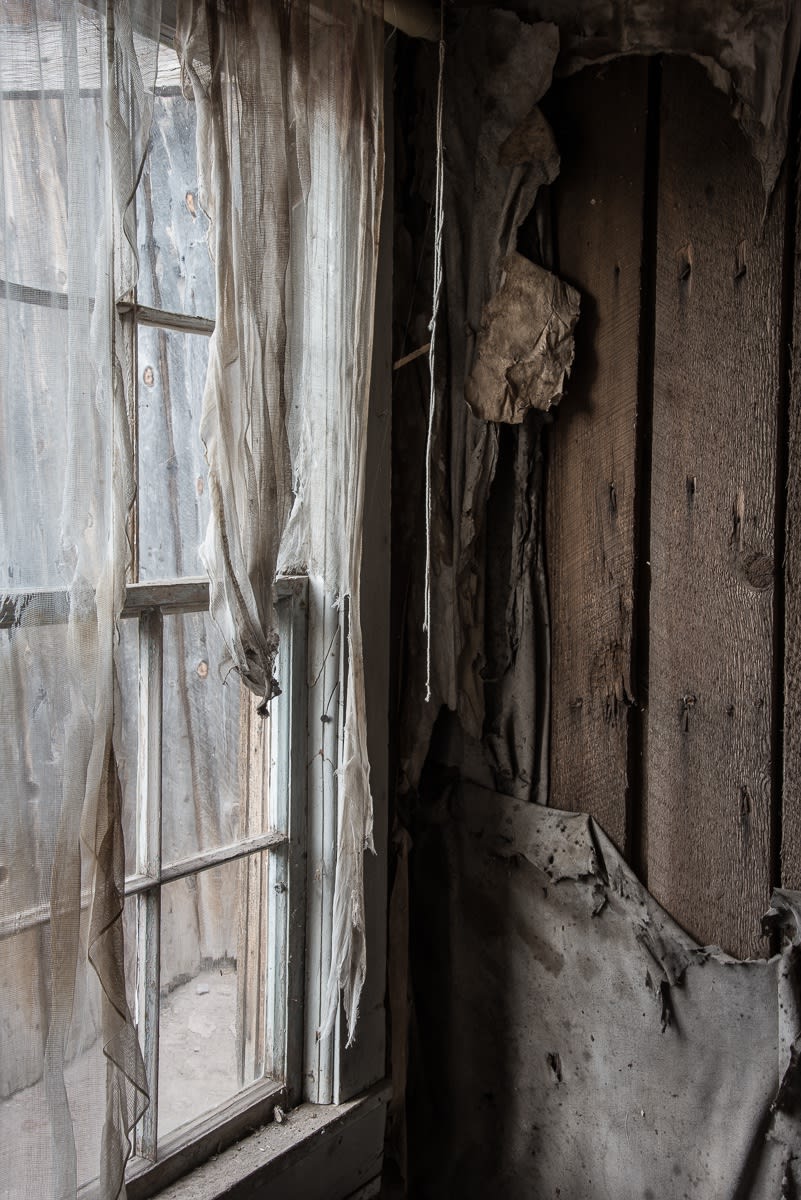
In the image “Torn Curtain”, we see the corner of an old room. Torn, thin, transparent curtains barely cover a window with a gentle light from outside coming through. Any other time of day, the light might of been too harsh and bold and would have disrupted the sense of this image. We see the bare wood walls where some type of paper or material is falling away. The wood is weathered as is the material. A pair of strings hang loosely down that at one time served a purpose, but now just floats in the image. Peering through the window we can just make out barren walkway and old wooded fence. The image suggests that there was no view for the person(s) in this room. Whatever view there might have been was given-up a long time ago. The window was probably there only to let in light.
Hulden’s prints draw in the viewer. Her traditional images capture what she observed. She was influenced by many traditional photographers including Ansel Adams, Paul Caponigro, ,Josef Sudek, George Tice, Minor White, Eliot Porter, Wynn Bullock, Laura Gilpin and Robert Adams, to name a few. She is able to develop her style from the study of photographers like these as their images have survived to be seen and shared. With billions of images created everyday, one day, those images will be lost as technology changes or the digital files are deleted or lost. Think how often we look to images created in the past to understand a point in history, society, family or culture.
At the same time, a print gives us visual pleasure, memory and a sense of peaceful coexistence with a place like “Bodie” or a landscape. Hulden brings a very different perspective to our environment. Where others created sculptural works, a work on paper can be held and felt. Physical prints are disappearing as a percentage of all images created. Without physical images to see and study Hulden, and other artists, would not be able to learn from other photographers. We have seen how important seeing art in person, or in images can be to influencing artist and ourselves. It makes an artfully created physical print all the more precious.
To live with one of her images is to enter into the past. The power in these images is to carry the viewer back in time, carefully and gently.The pastel colors give a gentle feel, not abrupt or shocking. We feel the emptiness of the place, but at the same time know that people once lived there.

In the other image “Spectacles”, a pair of old eyeglasses rest on fading papers of some kind. What is notable is the layered dust, on everything. Both the lenses of the spectacles are thickly covered in dust. One arm of the glasses had broken off some time in the past. Dust covers the papers on which these spectacles rest. One can imagine the former resident, in a period before TV, or maybe even radio, sitting quietly by a oil or gas lamp reading. We wonder why the glasses were left there? Did that person just get up and leave, never to come back or just forget to take them? Or, perhaps died and no one ever came back to claim this place and clean it up. This image gives us open ended questions and a sense of time and place.
When we stop and reflect upon the work of all four of these photographers, we have a unique stage from which to view ourselves, what we are doing, and how we live. The differences in these photographic styles, in part, arise because these photographers represent a range of experiences. The review of photographers at the Medium Festival of Photography turned out to be a very democratic process. These artists were selected based on the images produced. Looking beyond these images to the artist, one realizes that, by total coincidence, there are two men and two women in this commentary. They are young, just emerging photographers, mid-career, and well experienced photographers. Some are in the beginnings of their careers and others are on a second career. Some have trained as photographers and others have spent time in other artistic areas and migrated into photography or incorporated photography into their newest works. At the end of the day, the appreciation of an art object is all about the image or the object. Some of the objects are small works on paper and intimate, others large, and still others are three dimensional. These photographers show that appreciating a work of art is not about “how” it is created, or the pedigree of who created it. The appreciation of a work, is all about the work. These artists have created works that should, and will be, appreciated.
Notes:
- http://robgrad.com/contemporary-mixed-media-artist/
- http://www.kristasvalbonas.com
- See https://fotorelevance.com/naoya-hatakeyama-a-photographers-view/ for a discussion on vernacular photography
- For a discussion on sculpture and photography see comments in https://fotorelevance.com/paris-photo-trends-photography/
- http://drewleventhal.com/galleries-2/collage/
- http://www.jodiehulden.com/about/